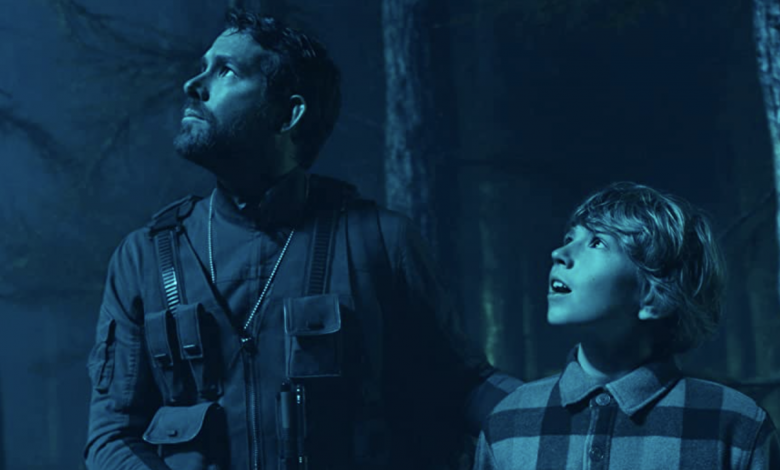The Adam Project Review

Charlie von Peterffy ‘24 / Entertainment Monthly Staff Writer
The Adam Project is about a man, Adam Reeds (Ryan Reynolds), who travels back in time to save his wife from death only to discover a malicious plan for someone to take control of time travel all whilst dealing with his own past trauma. Mistakenly launching back to 2022, he meets his younger self and analyzes the mistakes that he made from that age because of the death of his father. As the two try to understand each other, they team up to travel to the original destination, 2018, to save Reed’s wife. Instead, they discover that she is killed by Reed’s boss in the future in a plot to take control of time and space as she wants. To stop her, Reed goes to his father, who is also the accidental creator of time travel. In trying to save time and space as they know it, the three deal with their past, present, and future issues together, helping Reed to accept his past and look forward with a more optimistic view.
The Adam Project is a film that should not work; it has lots of cheesy one-liners, melodramatic dialogue, vague time travel rules, and a break-neck pace that skips through many character moments. It doesn’t have as much depth as it could because of these issues, turning its intriguing premise of a guy going back in time and literally dealing with past trauma into a predictable and two-dimensional sci-fi adventure. But, somehow, it uses these flaws to create a piece filled with soul, action, and inspirational ideas; it has enough spontaneous action, mesmerizing visuals, stellar performances, and unique chemistry to pass. It also has many familiar – but well presented – sci-fi tropes, making this a nostalgia feast for all ages.
The story itself is intriguing in idea but uninspired in its execution. The idea that a time traveler has to go back in time to save his wife, only to run into his younger self and long-dead father that forces him to deal with his trauma, is a refreshing idea of quite literally accepting one’s past. The heart of this idea certainly comes through, and quite well. However, it rushes itself, glossing over important character moments and replacing them with gaggy one-liners and sentimentality-filled sequences. It just doesn’t dive into its roster’s personalities enough to succeed in fulfilling anything more than superficial emotional reliability.
The cast is perfect. Each actor fills their character with enough emotion to convince and witty humor to satisfy. Ryan Reynolds as the older Adam Reed steals the show, but co-star Walker Scobell as the younger version of Adam deserves a lot of praise. It is hard to match Reynolds’s wit, charisma, and self-deprecating nature, but Scobell pulls it off. The chemistry and charm of these two and the realism of the rest of the cast make the film’s characters unmissably entertaining.
The cast also makes the film incredibly funny. The most substantial aspect of the film is the humor, so having natural comedians thrown into the mix certainly bolsters that. Without them or these jokes, this movie would fail.
The characters themselves have both strengths and weaknesses. On the one hand, they all have relatable character arcs and realistic emotional reactions. Trauma from childhood, especially with a parent, is something that most people experience, and this film indeed hits on that note. The film also has a lot of heart in general, making these characters feel closer to viewers than one might expect. Unfortunately, on the other hand, the film is too simplistic to delve far into these character arcs. As previously said, the film rushes at a sprint, glossing over many crucial character moments. Therefore, these moments skip rapidly to get to the next gag or action sequence. It doesn’t occur that frequently, though, so it is more forgivable than the film’s other flaws.
The visuals and score are both fantastic. Realistic CGI, engaging music sequences, and impressive action come together to create a dazzling firework show. The stunts are also reminiscent of other franchises like the John Wick and Kingsman films, with their one-shot movements and quick finishers. Not only is it pleasing to watch, but it also adds a subtle nod to the movies that came before.
The one visual issue that stands out is the de-aging of the main villain, Maya Sorian (Catherine Keener). Sorian shows up both from Reed’s present time and in the past. To achieve this, the filmmakers digitally de-aged the younger Sorian, but with rough results. She looks more like a video game character than anything; her features are blurry, the edges contrast too sharply from her surroundings, and her mannerisms barely come through. She does not even look like her unaltered counterpart. She looks more like a relative.
The last issue with this film is its vague explanation of time travel. Because of the extensive list of different time travel explanations and methods, this film creates a new one to differentiate itself from the rest. Unfortunately, the filmmakers do not explain it well enough. In a throwaway line, Reed explains to his younger self how it works, and then a few points mention it later on. But it is never extensively described, leaving some events feeling inconsistent with this explanation. The filmmakers should have dedicated more time to it to avoid this issue.
Overall, The Adam Project succeeds more often than flounders because of its heart, cast, visuals, humor, and nostalgia. It may not be the most profound viewing experience, but it is undoubtedly one everyone can laugh along with.